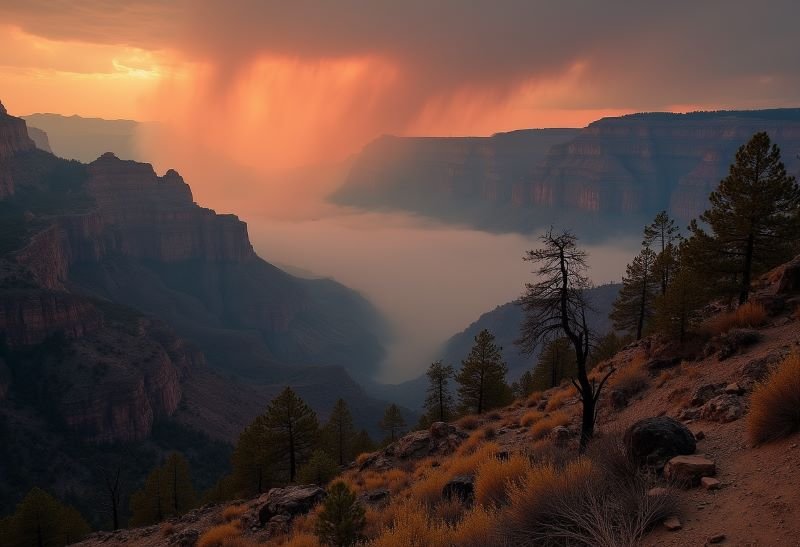North Rim Affected by Catastrophic Wildfire
On July 4th, a wildfire ignited by a lightning strike in Grand Canyon National Park has caused significant damage, destroying over 70 structures, including the historic Grand Canyon Lodge. The blaze has scorched more than 13,600 acres, with only 18% contained by July 21st. The ongoing fire poses a major threat to the area’s cultural and natural resources.
The Loss of Grand Canyon Lodge
Established in 1928 and rebuilt after a fire in 1937, Grand Canyon Lodge was a vital historic site, being the only accommodation on the North Rim. It attracted visitors seeking a quieter experience compared to the South Rim, offering stunning views of the canyon and contributing to the region’s tourism economy.
The loss of this iconic building means a cultural void, along with economic ramifications for local tourism. With limited other lodging options in the remote North Rim area, the closure of the lodge has adversely affected many businesses, notably Canyon Trail Ride.
Impact on Local Businesses and Employees
Canyon Trail Ride, a family-run business famous for its mule rides over the North Rim for more than 40 years, has announced it will close for the season. This tourism-dependent operation has already charged back over $100,000 to customers who had booked rides in advance. Owner Tawn Mangum lamented the situation, stressing the heavy toll on his twelve employees who are now facing uncertainty.
This sudden shutdown is particularly hard on those employees, many of whom have worked there for years. Mangum’s worries extend beyond his business; he sees this closure as detrimental to the wider community that relies on tourism.
State and Federal Officials Respond
In light of the devastation, Arizona Governor Katie Hobbs has called for a comprehensive investigation into the fire response. She criticized the management of initial controlled burns that spiraled out of control. Gov. Hobbs stressed the urgency for improved fire safety protocols to prevent future incidents of this scale.
Arizona Senator Reuben Gallego echoed the community’s concerns and described the vital role tourism plays in the local economy. He proposed the introduction of grants or low-interest loans to assist affected small businesses during this challenging period, advocating for support that could be crucial for recovery.
Continuous Firefighting Activities
As of July 21, over 850 personnel have been engaged in fighting the Dragon Bravo Fire, utilizing helicopters, bulldozers, and other tools to slow its spread. Unfortunately, the fire continues to pose a serious risk due to high temperatures, dry conditions, and difficult terrain.
The National Park Service assures the public that they are working diligently to contain further damage and prioritize the safety of residents, visitors, and staff.
Visitor Access and Trail Closures
This season, short-term closures at North Rim in Grand Canyon National Park are expected to limit summer traffic significantly. Several trails remain shut, including the North and South Kaibab Trails, which are the main routes to the canyon bottom. Visitors are encouraged to reconsider their plans and explore the South Rim or other sections of the park instead.
Details regarding the latest trail closures due to the fire are available on the NPS website. Those intending to visit the Grand Canyon should check for real-time updates on the official NPS site or its social media channels.
Ways to Support Recovery Efforts
As recovery efforts advance, local organizations along with park officials are outlining ways for people to contribute. If anyone wishes to donate to help restore North Rim and assist struggling businesses, they are encouraged to visit the Grand Canyon National Park website. A volunteer program is also being planned to aid in the cleanup and rebuilding of facilities affected by the fire.
Currently, the community is rallying to preserve the unique character and economic vitality of North Rim. With the fire still ongoing, it will likely take time before the area can fully recover and reopen to the public. The Grand Canyon holds immense value, both historically and culturally, and many are looking forward to a recovery process in the coming months.







